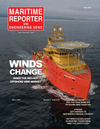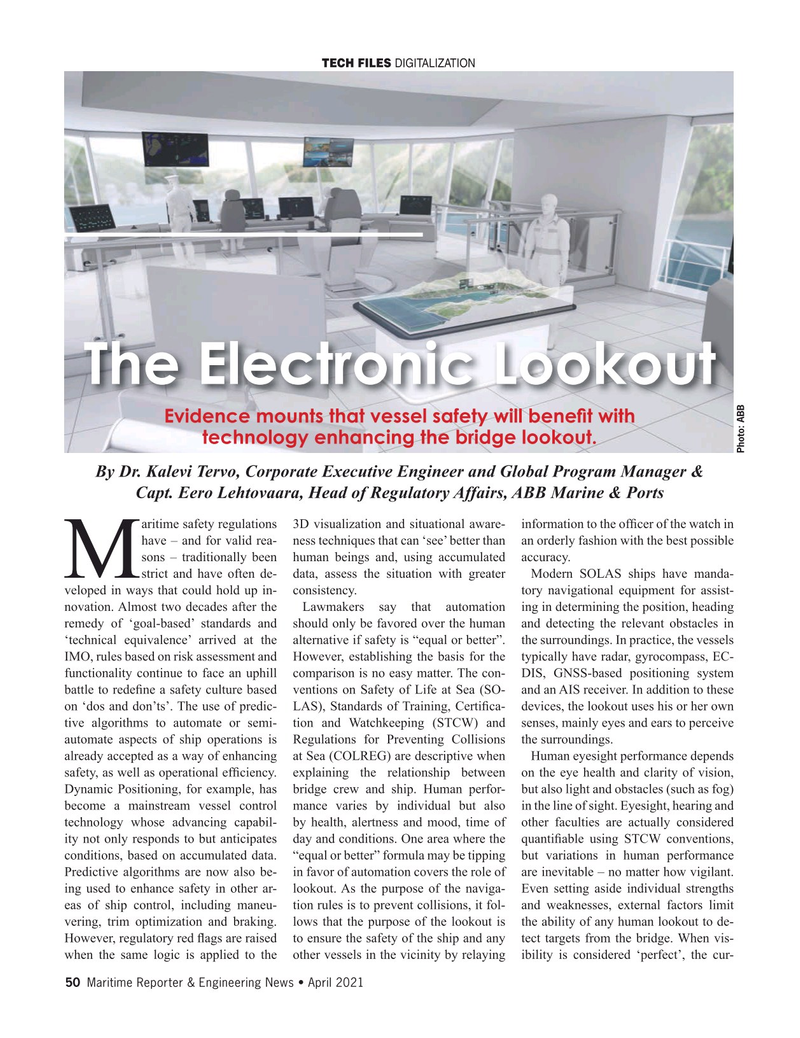
Page 50: of Maritime Reporter Magazine (April 2021)
Offshore Wind Energy: Installation, Crew & Supply Vessels
Read this page in Pdf, Flash or Html5 edition of April 2021 Maritime Reporter Magazine
TECH FILES DIGITALIZATION
The Electronic Lookout
Evidence mounts that vessel safety will bene? t with technology enhancing the bridge lookout.
Photo: ABB
By Dr. Kalevi Tervo, Corporate Executive Engineer and Global Program Manager &
Capt. Eero Lehtovaara, Head of Regulatory Affairs, ABB Marine & Ports aritime safety regulations 3D visualization and situational aware- information to the of? cer of the watch in have – and for valid rea- ness techniques that can ‘see’ better than an orderly fashion with the best possible sons – traditionally been human beings and, using accumulated accuracy.
Mstrict and have often de- data, assess the situation with greater Modern SOLAS ships have manda- veloped in ways that could hold up in- consistency. tory navigational equipment for assist- novation. Almost two decades after the Lawmakers say that automation ing in determining the position, heading remedy of ‘goal-based’ standards and should only be favored over the human and detecting the relevant obstacles in ‘technical equivalence’ arrived at the alternative if safety is “equal or better”. the surroundings. In practice, the vessels
IMO, rules based on risk assessment and However, establishing the basis for the typically have radar, gyrocompass, EC- functionality continue to face an uphill comparison is no easy matter. The con- DIS, GNSS-based positioning system battle to rede? ne a safety culture based ventions on Safety of Life at Sea (SO- and an AIS receiver. In addition to these on ‘dos and don’ts’. The use of predic- LAS), Standards of Training, Certi? ca- devices, the lookout uses his or her own tive algorithms to automate or semi- tion and Watchkeeping (STCW) and senses, mainly eyes and ears to perceive automate aspects of ship operations is Regulations for Preventing Collisions the surroundings. already accepted as a way of enhancing at Sea (COLREG) are descriptive when Human eyesight performance depends safety, as well as operational ef? ciency. explaining the relationship between on the eye health and clarity of vision,
Dynamic Positioning, for example, has bridge crew and ship. Human perfor- but also light and obstacles (such as fog) become a mainstream vessel control mance varies by individual but also in the line of sight. Eyesight, hearing and technology whose advancing capabil- by health, alertness and mood, time of other faculties are actually considered ity not only responds to but anticipates day and conditions. One area where the quanti? able using STCW conventions, conditions, based on accumulated data. “equal or better” formula may be tipping but variations in human performance
Predictive algorithms are now also be- in favor of automation covers the role of are inevitable – no matter how vigilant. ing used to enhance safety in other ar- lookout. As the purpose of the naviga- Even setting aside individual strengths eas of ship control, including maneu- tion rules is to prevent collisions, it fol- and weaknesses, external factors limit vering, trim optimization and braking. lows that the purpose of the lookout is the ability of any human lookout to de-
However, regulatory red ? ags are raised to ensure the safety of the ship and any tect targets from the bridge. When vis- when the same logic is applied to the other vessels in the vicinity by relaying ibility is considered ‘perfect’, the cur- 50 Maritime Reporter & Engineering News • April 2021
MR #4 (50-59).indd 50 4/5/2021 2:35:54 PM

 49
49

 51
51
